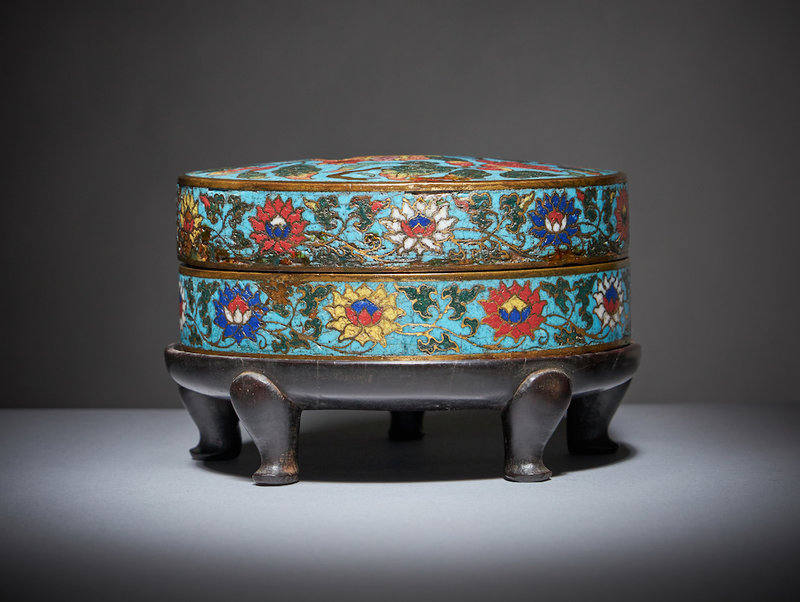Discovery of important Chinese Ming Cloisonne box in family attic
An exceptionally rare Chinese cloisonné ‘pomegranate’ box and cover, Xuande incised six-character mark and of the period (1426-1435). Estimate £6,000-£10,000. © 2023 Dreweatts 1759 Ltd
LONDON.- An exceptionally rare Chinese cloisonné ‘pomegranate’ box and cover from the Ming period has been discovered in a dust-filled cabinet in the attic of a family home, where it had been stored and left untouched since the owner’s death in 1967. This important box bearing the incised six-character marks of Xuande, the fifth Emperor of the Ming Dynasty (1426-1435), was nestled in a dusty cabinet amongst other cloisonné pieces and it was only on close inspection many years later that it was found.
The box comes from the collection of the late Major Edward Copleston Radcliffe (1898-1967), having been acquired at Sotheby’s in London in 1946 and then exhibited in the National Gallery of South Africa’s Chinese Exhibition in Cape Town in 1953. It is one of only four other known examples, including one in the Palace Museum, Beijing. Three are in museum or institutional collections and only this box and one other remain in private hands. Dr Yingwen Tao, specialist in Chinese and Asian Art at Dreweatts tells us; “There is every indication that all five were made in the same Imperial workshop, for the Emperor, as crucially all are doubly marked with an incised Xuande six-character reign mark on the underside of the box and the interior of the cover. They also all have similar designs and are uniform in size (12cm in diameter).”
Speaking about the discovery, Mark Newstead, Director of Asian Ceramics and Works of Art at Dreweatts, said: "The valuation came through a referral from a friend. When I first inspected the piece it looked too good to be true as 99.9% of Xuande marked pieces are later copies (it one of the most copied marks of all time used every decade since the Xuande reign) and is found on pieces from the 16th, 17th, 18th, 19th and 20th centuries. I assumed it was made in the 16th or early 17th century and it was only when my colleague Dr Yingwen Tao was able to compare it with the example at Fenton House that we started to believe it could be a ‘lost’ example of this rare group.”
Cloisonné enamel pieces from the early Ming period are exceptionally rare as production was strictly regulated by the Palace eunuchs, who operated under the auspices of the Yuyongjian, a sub-division of the Neifu, 'The Inner Treasury', responsible for supplies to the Imperial Household.
The decorative box is circular in shape and features two ripe pomegranates with gnarled gold branches, blossoms, smaller fruit and lotus scrolls. Pomegranates were an emblem of fertility and prosperity in the 15th century. As mentioned above, it bears the incised six-character marks of Xuande, the fifth Emperor of the Ming Dynasty (1426-1435) on its base and interior. It is estimated to fetch £6,000-£10,000. Mark Newstead states: “The initial estimate, which was based on it being from the 17th century is now looking extremely modest and it is now thought it could achieve much more, even in its slightly damaged condition.”
It will be offered for sale for the first time in 77 years, among other works collected by Major Edward Radcliffe between 1930-1965 in Dreweatts Chinese Ceramics & Works of Art & Japanese, Indian & Islamic Ceramics & Works of Art sale on 17th & 18th May, 2023.

/https%3A%2F%2Fprofilepics.canalblog.com%2Fprofilepics%2F1%2F0%2F100183.jpg)
/https%3A%2F%2Fstorage.canalblog.com%2F03%2F02%2F119589%2F96711876_o.jpg)
/https%3A%2F%2Fstorage.canalblog.com%2F11%2F31%2F119589%2F94773502_o.jpg)
/https%3A%2F%2Fstorage.canalblog.com%2F20%2F83%2F119589%2F94772815_o.jpg)
/https%3A%2F%2Fstorage.canalblog.com%2F26%2F72%2F119589%2F75604929_o.jpg)
/https%3A%2F%2Fstorage.canalblog.com%2F59%2F60%2F119589%2F26458628_o.jpg)





/http%3A%2F%2Fstorage.canalblog.com%2F40%2F03%2F119589%2F128033234_o.jpg)
/http%3A%2F%2Fstorage.canalblog.com%2F09%2F54%2F119589%2F127828285_o.jpg)
/http%3A%2F%2Fstorage.canalblog.com%2F41%2F70%2F119589%2F126539548_o.jpg)
/http%3A%2F%2Fstorage.canalblog.com%2F44%2F04%2F119589%2F76379864_o.jpg)